Caribbean Cooking for Beginners: Traditional Island Techniques
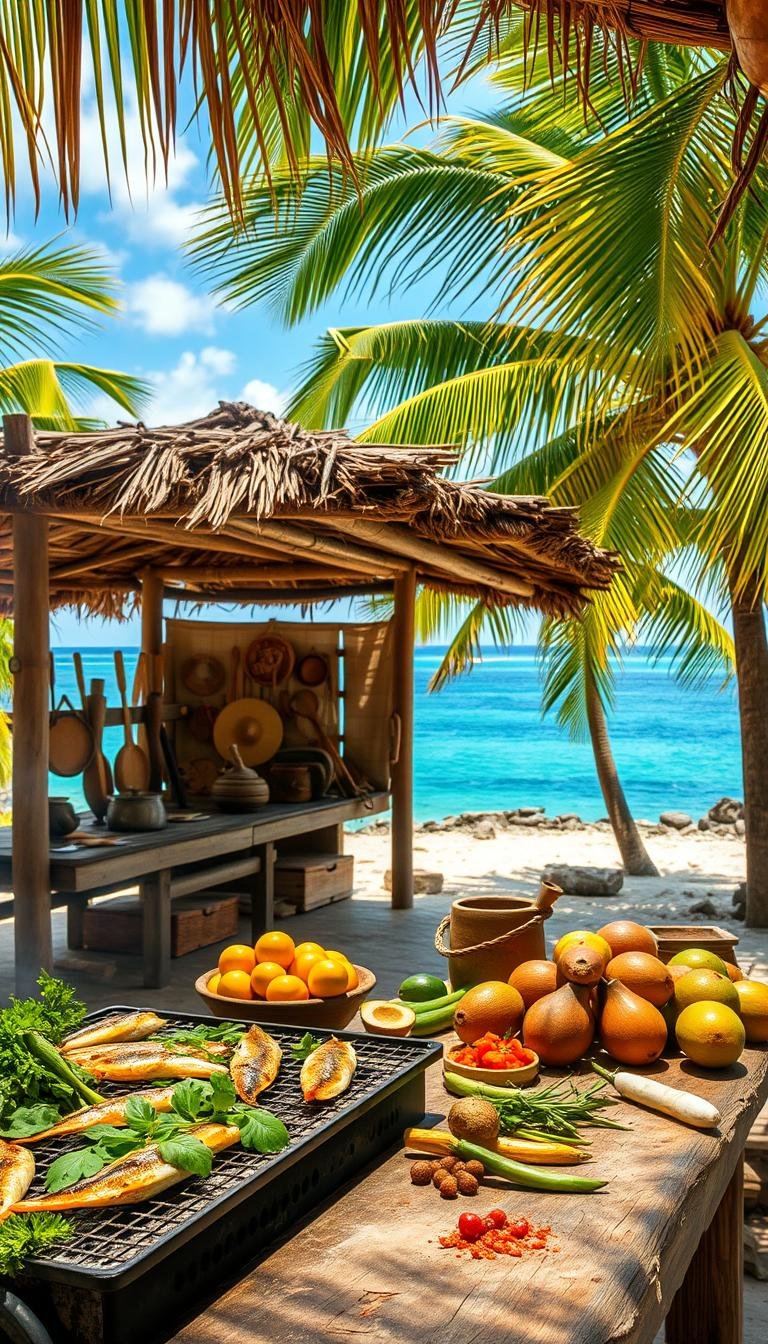
The first time I tasted jerk chicken, I fell in love with island food! The flavors were amazing – allspice, scotch bonnet peppers, and tropical fruits. It was like sunshine in my mouth.
I was in my kitchen, wanting to make those flavors at home. If you’re new to island cooking, don’t worry. It’s easier than you think! Traditional recipes are forgiving and share stories through food.
Island dishes come from necessity and creativity. They use simple techniques that anyone can learn. From slow-cooked meals to vibrant marinades, these methods are great for beginners.
In this guide, we’ll make these techniques easy to follow. We’ll explore essential flavors and how to adjust them to your liking. This will help you feel more confident in the kitchen.
Are you ready to add tropical flavors to your meals? Let’s start this tasty journey together!
Key Takeaways
- Island cuisine combines African, European, Indigenous and Asian influences
- Most traditional recipes use simple techniques perfect for beginners
- One-pot cooking methods make meal preparation manageable
- Spice levels can be easily adjusted to suit personal preferences
- Many authentic dishes require minimal specialized equipment
- Traditional techniques often allow for ingredient substitutions
Welcome to the Vibrant World of Caribbean Cuisine
When I first discovered Caribbean cooking, I was instantly transported to a world of bright flavors, aromatic spices, and joyful culinary traditions! Island cuisine combines simple ingredients into dishes that burst with personality. If you’re new to tropical cooking, you’re in for a treat that will transform your kitchen into a Caribbean paradise!
A Melting Pot of Flavors: Understanding Caribbean Culinary Heritage
Caribbean cuisine isn’t just delicious – it’s a fascinating history lesson on a plate! The food you’ll discover across these beautiful islands tells the story of centuries of cultural exchange and resilience. Before European colonizers arrived, indigenous Taíno, Arawak, and Carib peoples contributed foundational ingredients like cassava, sweet potatoes, and fiery peppers.
When I first learned about the complex origins of island cuisine, I was amazed by how many cultures had left their mark. The forced migration of enslaved Africans brought culinary techniques and ingredients that became central to Caribbean cooking – think okra, plantains, and yams. These elements merged with European influences and later, indentured laborers from India and China added their own culinary traditions.
What makes West Indian recipes so special is how they represent cultural adaptation and creativity. People worked with what was available, creating new dishes that honored their heritage while embracing their new home. This resilience shines through in every bite of authentic Caribbean food!
| Cultural Influence | Key Ingredients | Cooking Techniques | Signature Dishes |
|---|---|---|---|
| Indigenous | Cassava, peppers, corn | Barbacoa (barbecue) | Pepper pot, cassava bread |
| African | Okra, plantains, yams | One-pot cooking, stewing | Callaloo, fufu, pepperpot |
| European | Citrus, wheat, dairy | Baking, preserving | Rum cake, pastries |
| Indian | Curry spices, chickpeas | Curry preparation | Curry goat, roti |
| Chinese | Soy sauce, ginger | Stir-frying | Jamaican lo mein |
Why Caribbean Cooking Captivates Food Lovers Worldwide
The first time I tasted authentic jerk chicken with its complex spice blend and smoky heat, I was completely hooked! Caribbean spices create layers of flavor that are bold without being overwhelming. The cuisine masterfully balances contrasting elements – spicy and sweet, tangy and savory – often in a single memorable dish.
What I love most about tropical cooking is its celebration of fresh, vibrant ingredients. Island cuisine transforms humble components through clever techniques developed over generations. The results are dishes that feel both comforting and exciting at the same time!
Each Caribbean island brings its own personality to the table. Jamaica is famous for fiery jerk seasoning and hearty stews. Trinidad and Tobago showcase curry-infused dishes that reflect their Indian heritage. Puerto Rican cuisine centers around sofrito – a fragrant base of peppers, onions, garlic, and herbs that starts countless recipes.
Beyond the amazing flavors, Caribbean cooking offers something special – it connects us to stories of human creativity and resilience. These recipes emerged from challenging historical circumstances yet celebrate joy and community through food. That’s why island cuisine continues to win hearts worldwide!
Ready to bring these vibrant flavors into your own kitchen? Don’t worry about getting everything perfect right away. Caribbean cooking is about heart and soul, not rigid rules! In the coming sections, I’ll guide you through the essential ingredients, techniques, and beginner-friendly recipes that will have you cooking like an islander in no time!
Essential Caribbean Ingredients: Building Your Island Pantry
Ready to make your kitchen a Caribbean paradise? Let’s start with the key ingredients! Building a Caribbean pantry is easier than you think. Most items are in your local store or international market. Having them ready lets you make authentic island dishes anytime!
Spices That Define Caribbean Flavor: From Allspice to Scotch Bonnets
The heart of Caribbean cooking is its spices! When I started mybeginner guide to Caribbean seasonings, I found a few spices can change simple dishes into island wonders.Allspice berriesare a must – they taste like cinnamon, nutmeg, and cloves all in one! I crush them for the best flavor, but ground allspice works too.
Thyme is key in Caribbean cooking – I prefer fresh, but dried is okay. Mix it with garlic, ginger, and onions for a smell that feels like home!

Now, let’s talk about heat!Scotch bonnet peppersadd the Caribbean fire that makes dishes pop. If you’re not used to spice, start with a little and add more as you get used to it!
Tropical Staples: Plantains, Yuca, and Sweet Potatoes
The Caribbean pantry includes more than spices. Starchy veggies like plantains, yuca, and sweet potatoes are key. Plantains are my favorite! They can be cooked at different stages for different tastes.
Green plantains make crispy tostones when fried twice – great for sauces! Ripe plantains become sweet maduros when fried, balancing spicy dishes. Simpleplantain recipesare great for beginners.
Yuca is a forgiving root for new cooks. I boil it, then fry it for a crispy outside and fluffy inside. Sweet potatoes add natural sweetness to Caribbean dishes.
Proteins of Paradise: Fresh Seafood and Traditional Meats
Caribbean cooking loves the sea and hearty meats. Fresh fish like red snapper and mahi-mahi are favorites, often with spice rubs or in stews.
If fresh seafood is hard to find, chicken is versatile. It’s great in jerk or curry dishes. Pork and goat are also big in Caribbean cooking, like pernil and Jamaican curry goat.
Caribbean cooking uses every part of the animal. Try oxtails, salt fish, and pig tails in stews! Start with familiar proteins and try new ones as you get more confident.
Coconut in All Its Forms: Milk, Oil, and Fresh Flesh
Coconut is the heart of Caribbean cooking. I useeverypart of it in my kitchen.Coconut cookingtechniques vary, but its versatility is universal.
Coconut milk adds creaminess to curries and stews. I always have a few cans for instant flavor! Coconut oil is great for frying plantains or sautéing veggies.
Fresh coconut flesh adds texture and sweetness to desserts and salads. If you can’t find fresh coconuts, try frozen grated coconut. Coconut’s sweetness balances the heat from scotch bonnets and spices.
Don’t worry about these ingredients! Start with what you have and add more as you go. Soon, you’ll be cooking like the islands in your own kitchen!
Traditional Caribbean Cooking Techniques Every Beginner Should Master
Caribbean cooking mixes old traditions with easy methods for beginners. It turns simple ingredients into amazing meals full of island flavors! I’ve learned these techniques in my kitchen and can’t wait to share them with you. Let’s dive into the basic techniques that bring real Caribbean tastes to your table!
The Art of Marinating: Infusing Deep Island Flavors
Marinating is key in Caribbean cooking! It lets spices and aromatics soak into meats, seafood, and veggies. Remember, patience is key here – good things take time!
Marinating mixes acidic ingredients like lime or pineapple juice with spices. The acid tenderizes proteins and lets them soak up flavors. For the best results, marinate chicken for at least 4 hours, or overnight if you can.
My basic Caribbean marinade includes:
- Fresh lime juice (the acid that tenderizes)
- Minced garlic and ginger (aromatic base)
- Chopped thyme and scallions (herbaceous notes)
- A touch of scotch bonnet pepper (for that signature heat)
- Brown sugar (balances the acidity and helps with caramelization)
Save some marinade before adding raw meat if you want to use it as a sauce later. Always think about food safety first!
Jerk Seasoning Magic: Creating the Perfect Spice Blend
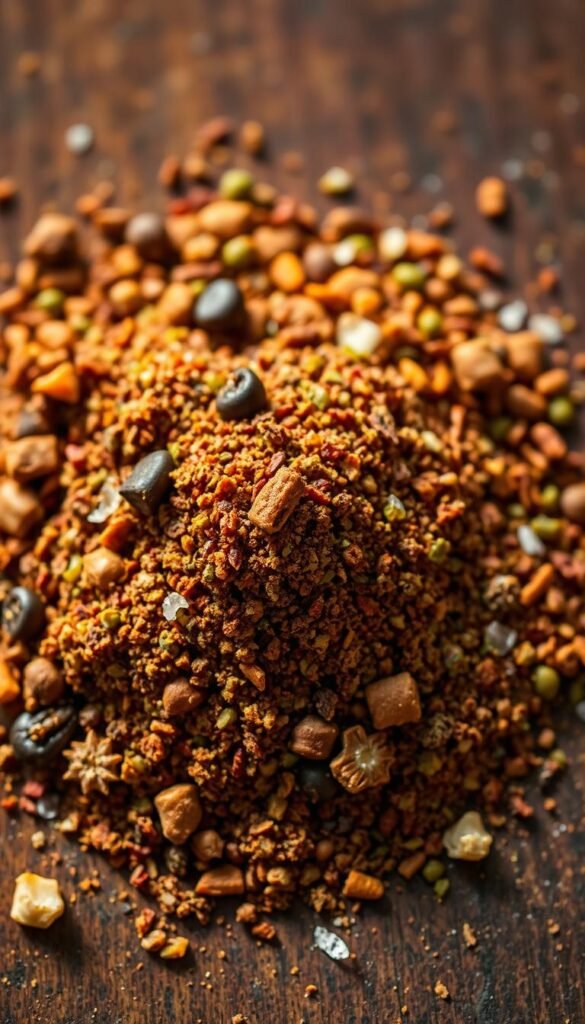
Jerk seasoning is a highlight of Jamaican cuisine and a top Caribbean flavor. Making your own jerk seasoning lets you adjust the heat. My version has all the authentic flavor without too much spiciness.
Basic Jerk Seasoning Blend mixes allspice, thyme, brown sugar, cinnamon, nutmeg, garlic powder, ginger, and scotch bonnet peppers. Traditionally, you grind these into a coarse paste with a mortar and pestle. But a food processor works well for beginners.
The secret to great jerk is balance. Aim for a mix of sweet, savory, and spicy. Start with less heat and add more as you get used to Caribbean flavors.
Slow Cooking Caribbean Style: Braising and Stewing Techniques
Slow cooking is perfect for beginners! These methods let flavors develop slowly and need little attention. They’re great for busy beginners!
Caribbean stews start with browning meat to add flavor. Then, a slow simmer with aromatics, veggies, and coconut milk or broth makes tough meat tender and flavorful.
One easy dish is a simple chicken stew. Brown chicken, then add onions, bell peppers, garlic, thyme, and coconut milk. Simmer for 45 minutes for a comforting meal that tastes like it’s been cooking all day!
Grilling and Roasting: Bringing Out Natural Tropical Flavors
Grilling and roasting highlight the sweetness of Caribbean ingredients. These methods are simple yet impressive. They’ll wow your family and friends!
Traditional Caribbean grilling uses makeshift grills or open flames, but your backyard grill works too. Control your heat—medium-high is best. For authentic flavor, add soaked pimento wood chips to your grill.
Roasting brings out the sugars in tropical veggies and fruits. Roasting plantains with coconut oil and salt is delicious. The outside caramelizes while the inside stays creamy and sweet.
| Technique | Best For | Beginner Tip | Flavor Profile |
|---|---|---|---|
| Marinating | Chicken, pork, fish | Start with 4-hour minimum | Deep, complex, aromatic |
| Jerk Seasoning | Chicken, pork, vegetables | Reduce scotch bonnet amount | Spicy, woody, slightly sweet |
| Slow Cooking | Tough meats, stews | Don’t rush—low and slow wins | Rich, developed, comforting |
| Grilling/Roasting | Fruits, vegetables, seafood | Watch closely to prevent burning | Caramelized, sweet, smoky |
These Caribbean cooking techniques might seem hard at first, but they’re easy for beginners. Caribbean cooking is flexible, so you can add your own twist. Start with these basics, and soon you’ll be making authentic island flavors!
Remember, practice makes perfect. Each time you marinate or blend jerk seasoning, you’ll get better. Soon, these techniques will be second nature, and you’ll be ready to try more Caribbean dishes!
Essential Equipment for Your Caribbean Kitchen Adventure
Ready to bring the islands to your kitchen? Let’s explore the essential equipment for a Caribbean culinary paradise! You don’t need fancy gadgets or expensive items. In fact, traditional tools have been used in island kitchens for generations!
Traditional Tools: Mortars, Pestles, and Wooden Spoons
A mortar and pestle is key for tropical cooking. It’s called a “pilón” in some islands. I use mine to crush garlic, grind spices, and make marinades. It releases oils and flavors that food processors can’t match!
Size doesn’t matter – even a small mortar and pestle makes a big difference. Stone or wooden varieties work well. I prefer stone for spices and wood for garlic and herbs.
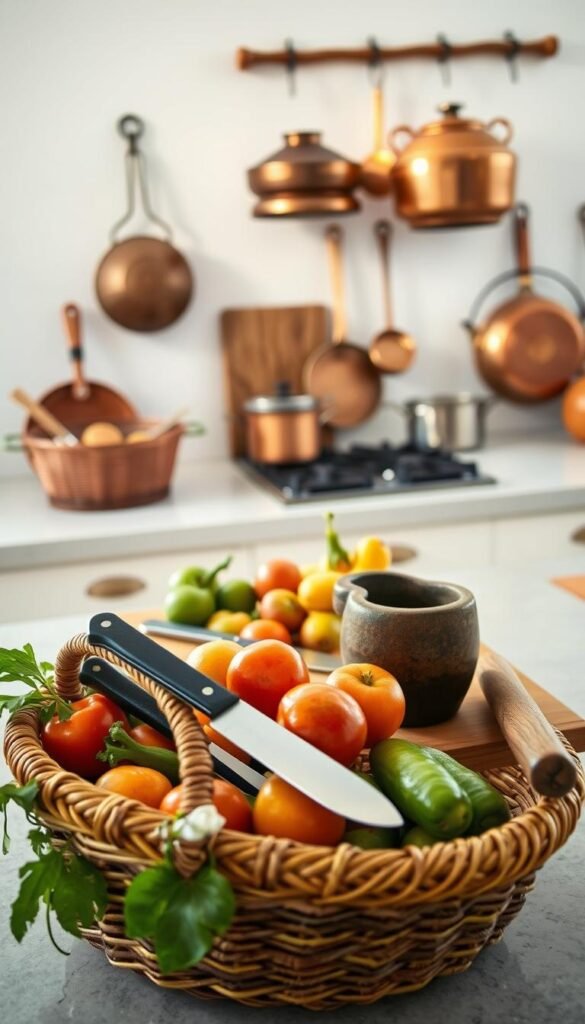
Wooden spoons are a must for Caribbean kitchen essentials for starters. They’re great for stirring stews without scratching pots. They also keep your hands safe from heat. I have at least three sizes for different tasks.
Sharp knives are essential for tropical ingredients. They’re needed for breaking down coconuts to finely dicing scotch bonnet peppers. Remember, a sharp knife is safer than a dull one!
Modern Conveniences That Honor Traditional Methods
While traditional tools are key, some modern appliances help too. A quality blender is at the top of my list of Caribbean kitchen essentials. I use mine weekly for smooth marinades, sauces, and smoothies.
A heavy-bottomed Dutch oven is great for long-simmering stews and braised dishes. It prevents burning and develops complex flavors. If you get one pot, make it this one!
For grilling, a simple grill basket is perfect for cooking delicate fish. It prevents sticking and falling through grates.
A rice cooker is not essential but saves time since rice is a staple. It lets you focus on your main dish while ensuring perfect rice. I use mine at least twice a week!
Caribbean cooking started in humble kitchens with simple tools. It’s about technique and ingredients, not fancy gadgets! Start with these basics and you’ll be ready to explore island flavors. As you get more confident, you can add more tools to your collection.
Beginner-Friendly Caribbean Dishes to Start Your Journey
Now that you’ve got your pantry stocked and techniques down, it’s time to start cooking. I’ve picked recipes that are easy, tasty, and great for beginners. These simple Caribbean dishes for new cooks will introduce you to real island tastes without being too hard.
Rice and Peas: The Quintessential Caribbean Side Dish
Rice and peas is a staple in the Caribbean. It’s actually made with kidney beans, not peas. This dish is a key part of many meals and is easy for beginners.
To make authentic rice and peas, you’ll need:
- 1 can of kidney beans
- 1 can of coconut milk
- 2 cups of long-grain rice
- Fresh thyme sprigs
- 2 cloves of garlic, minced
- 1 small onion, diced
- 1 scotch bonnet pepper (whole, for flavor without extreme heat)
First, sauté the onion and garlic. Then add the beans, coconut milk, thyme, and scotch bonnet. Bring to a simmer, add rice, and cook until tender. This side dish is fragrant and flavorful, perfect with many Caribbean dishes! For more Caribbean side dishes, check out this link.
Simple Jerk Chicken: Your Gateway to Bold Island Flavors
My simple jerk chicken recipe is a hit for beginners! It’s easy to make and full of flavor. It’s a great easy Caribbean dinner idea for novices because it’s hard to mess up.

- 3 tablespoons of allspice
- 4 cloves of garlic, minced
- 1 tablespoon fresh thyme leaves
- 1 tablespoon grated ginger
- 2 tablespoons soy sauce
- 2 tablespoons brown sugar
- ¼ cup lime juice
- 1 scotch bonnet pepper (adjust to your heat preference)
Blend all the ingredients together and marinate chicken thighs overnight. Then, grill or bake until done. The jerk seasoning gives a sweet, spicy, and savory taste that feels like Jamaica. The longer you marinate, the stronger the flavor will be!
Tropical Fruit Salad with Lime and Mint: Fresh and Refreshing
This tropical fruit salad is light and refreshing. It needs no cooking and highlights Caribbean fruits’ bright flavors.
For an authentic island taste, mix chunks of:
- Ripe mango
- Pineapple
- Papaya
- Banana
Add fresh lime juice and torn mint leaves for an instant island taste. This mango dish is versatile – serve it as a light dessert, a refreshing side, or a topping for grilled fish. Use any tropical fruits you find at your local market.
Fried Plantains: Sweet and Savory Perfection
Fried plantains are my favorite Caribbean side dish! They can be prepared in many ways, depending on their ripeness. This makes them perfect for trying out plantain recipes.
For sweet maduros, use plantains with black spots. Slice them diagonally about ½-inch thick and fry until golden brown. They’re naturally sweet and pair well with savory dishes!
For tostones, use green plantains. Slice, fry briefly, smash flat, and fry again until crispy. Sprinkle with salt and serve as a starchy side like potatoes. Both maduros and tostones are Caribbean cooking staples that are easy for beginners to master.
These recipes are just the start of your Caribbean cooking journey! As you get more confident, you can try more complex dishes and explore different regions. The Caribbean recipes collection has lots of ideas for your next cooking session. Caribbean cooking is all about bold flavors, fresh ingredients, and having fun in the kitchen!
Regional Variations: Exploring Different Island Cooking Styles
Traveling through Caribbean cuisine is like island-hopping through distinct flavor territories. Each island has its own unique techniques and dishes. You can easily recreate these in your own kitchen!
Jamaican Classics: Bold Spices and Hearty Comfort Foods
Jamaica’s cuisine is known for its bold, unforgettable flavors. While jerk seasoning is famous, there’s more to try. Start with Jamaican curry chicken, which uses island spices like thyme and Scotch bonnet peppers.
Try making escovitch fish for a tangy, spicy dish. It’s fried fish topped with a vinegar sauce and colorful bell peppers. The crispy fish and bright sauce are a perfect mix!
Beef patties are Jamaica’s favorite snack. These flaky pastries are filled with seasoned ground beef. They’re easy to make and delicious.
Puerto Rican Traditions: Sofrito and Slow-Cooked Specialties
Puerto Rican cooking is all about sofrito. This mix of peppers, onions, and herbs is used in almost every dish. Make big batches and freeze it for later.
Start with arroz con gandules (rice with pigeon peas) for a taste of tradition. Mofongo, with its mashed plantains and garlic, is also easy to make. The process of mashing the plantains is fun and rewarding!
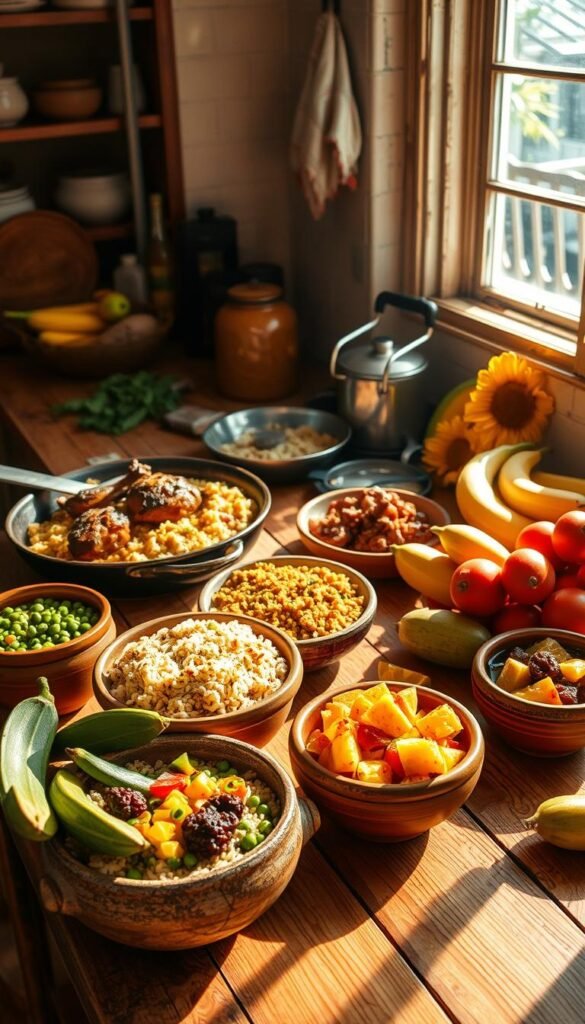
Barbadian Delights: Flying Fish and Cou-Cou
Barbados’ cuisine is all about seafood. The national dish is flying fish and cou-cou, a cornmeal side. Use any firm white fish for a great substitute.
Make Bajan fish cakes for a tasty snack. Pair them with a rum punch for a true island vibe. Barbados is the birthplace of rum, so using it in dishes is a must-try.
Cuban Influences: Citrus Marinades and Roasted Specialties
Cuban cooking is known for its simple yet flavorful dishes. Mojo marinades are key, using citrus and garlic to enhance meats. Sour orange juice is traditional, but orange and lime juice work well too.
Try ropa vieja, a tender shredded beef dish. It’s cooked with bell peppers and tomatoes. Cuban black beans and rice also showcase the island’s Spanish roots.
Don’t worry if you’re overwhelmed by all the options. Start with what interests you and explore from there. Caribbean cooking is all about flavor and history, even in simple dishes.
Mastering Caribbean Sauces and Condiments
Exploring Caribbean cooking, I found that sauces and condiments make island cuisine shine. They’re not just extras; they’re key to making meals taste like the Caribbean. Plus, making them at home is easy, even for beginners!
Hot Sauce Fundamentals: Balancing Heat with Flavor
No Caribbean table is complete without homemade hot sauce! The secret is balancing flavors, not just heat. Scotch bonnet peppers add a unique Caribbean warmth that’s spicy yet fruity.
Start with a simple recipe: blend 2-3 scotch bonnet peppers (seeds removed for less heat), 1/4 cup vinegar, 2 garlic cloves, and a small mango or pineapple. The fruit balances the heat and adds tropical flavor!
Remember, you can always add more heat, but you can’t take it away! For beginners, start with half a pepper and adjust to taste. Store it in a glass bottle in the fridge for weeks of Caribbean flavor!
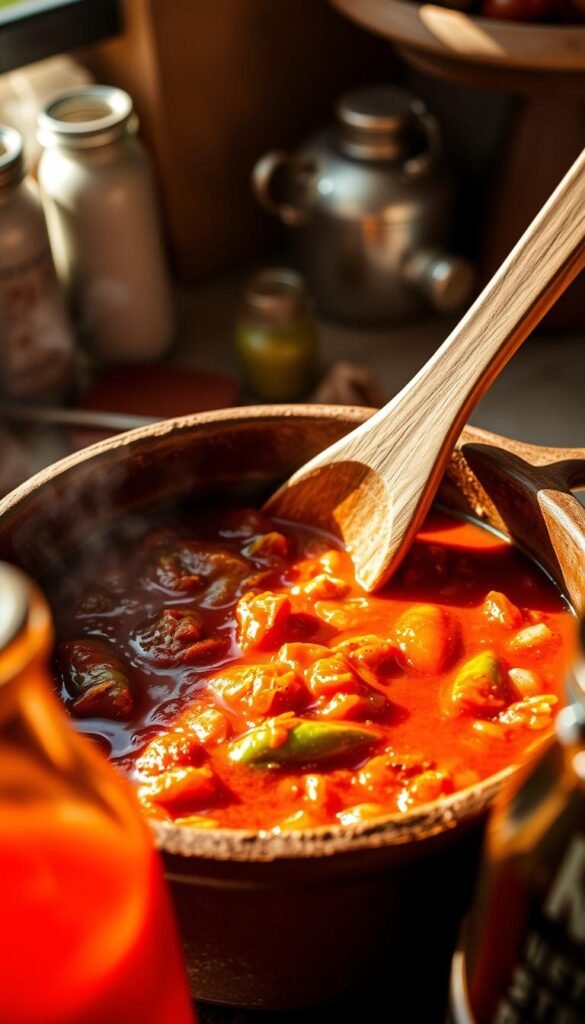
Mojo Marinades: Citrusy Garlic Perfection
Mojo marinades are great for quick meals with Caribbean flair. The mix is simple: citrus juice, garlic, oregano, and olive oil. Lime juice works well for simple island recipes for new home cooks.
Mojo is versatile and works magic on chicken, pork, fish, and veggies! Mix 3 lime juices, 6 minced garlic cloves, 1 teaspoon dried oregano, 1/4 cup olive oil, and salt. Marinate chicken or pork for 30 minutes before grilling or roasting.
Mojo brightens everything with zesty, garlicky goodness. It’s perfect for meal prep too – make a batch on Sunday for busy weeknights!
Coconut-Based Sauces: Creamy Island Indulgence
For true Caribbean comfort, I use coconut cooking techniques, like creamy coconut sauces. They’re slightly sweet and great for balancing spicy dishes or adding richness to grilled seafood.
My favorite coconut sauce is 1 can of coconut milk, 1 tablespoon grated ginger, 2 minced garlic cloves, and a bit of curry powder. Simmer for 10 minutes until thickened. It’s amazing on fish, chicken, or veggies!
For a fruit twist, add diced mango to make delicious mango dishes with island flair. Mango’s sweetness pairs well with coconut, perfect for savory fish or desserts.
Making these sauces myself means no preservatives or artificial flavors. They keep well in the fridge for up to a week, making them perfect for meal prep. Start with your favorite sauce, and it’ll soon become a kitchen staple!
Common Mistakes and How to Avoid Them
When I first started exploring Caribbean cooking, I made plenty of rookie mistakes. These mistakes taught me valuable lessons! Learning any new cuisine is a journey, and even mistakes help you grow.
Let me share some common pitfalls I’ve encountered. This way, you can navigate your Caribbean culinary journey with more confidence!
Spice Level Disasters: Finding Your Perfect Heat Balance
Managing the heat is a big challenge for newcomers to Caribbean cooking. Those innocent-looking scotch bonnet peppers pack a serious punch. My first attempt at jerk chicken was practically inedible because I went all-in with the peppers!
My golden rule for caribbean cooking tips for kitchen novices is to start with way less heat than recipes suggest. You can always add more spice, but you can’t take it away once it’s in the pot! For beginners, I recommend using just a quarter of the peppers called for, then gradually increasing as your palate adjusts.
Another game-changing tip: remove the seeds and membranes from your hot peppers. That’s where most of the fire lives! This simple step lets you enjoy the wonderful fruity flavor of scotch bonnets without setting your mouth ablaze. Keep a dairy product nearby when cooking—a quick sip of milk can save you if you accidentally taste something too spicy!

Overcooking Seafood: Keeping Island Fish Tender and Flaky
Seafood is the star of many Caribbean dishes, but it’s notoriously easy to overcook! There’s nothing more disappointing than tough, rubbery fish or shrimp that should be tender and succulent. After many failed attempts, I’ve developed a foolproof approach to seafood cooking that works every time.
For fish, I swear by the “10-minute rule”—measure the thickest part in inches and cook for exactly 10 minutes per inch. If you’re grilling or pan-frying a 1-inch thick snapper fillet, that’s just 5 minutes per side. The fish should flake easily with a fork but still remain moist.
Shrimp cooks even faster! They’re done the moment they turn pink and opaque, which typically happens in just 2-3 minutes. I always set a timer because even 30 extra seconds can make the difference between perfect and overcooked. Remember that seafood continues cooking slightly after you remove it from heat, so it’s better to undercook slightly than go too far.
Ingredient Substitutions: When and How to Adapt Recipes
One of the biggest challenges for beginners is finding authentic Caribbean ingredients. Don’t panic if your local store doesn’t stock everything you need! Caribbean cooking evolved from making do with available ingredients, so substitutions are part of the tradition.
Can’t find scotch bonnets? Habaneros make an excellent substitute with a similar heat profile and fruity flavor. No fresh thyme? Dried works fine, but remember to use just one-third the amount since dried herbs are more concentrated. For caribbean ingredient basics for new chefs, knowing these equivalents makes all the difference.
Plantains can be tricky to find in some areas. For savory dishes calling for green plantains, firm green bananas can work in a pinch. For sweet applications, very ripe regular bananas will do the job—they’ll be softer but still delicious. Coconut milk is another staple that’s easy to substitute; if you can’t find canned versions, mix unsweetened coconut cream with water.
The most important tip I share in my beginner caribbean cooking class recipes is to taste as you go! Caribbean cooking is all about balancing flavors. If something seems “off,” it usually needs a little more acid (try lime juice), salt, or heat to bring everything into harmony.
Remember that even “mistakes” are valuable learning opportunities—and they’re usually still pretty tasty! The more you practice, the more intuitive Caribbean cooking will become. Soon you’ll be adjusting recipes on the fly like a true island chef, adapting to what’s available while maintaining those authentic tropical flavors we all love!
Building Confidence in Your Caribbean Cooking Journey
Starting your Caribbean cooking journey doesn’t have to be scary! Taking small steps is key to success. The rich traditions of Caribbean cooking become easier when broken down into simple steps.
Practice Makes Perfect: Starting Simple and Building Skills
Start with just one or two step by step Caribbean cooking for beginners recipes that you love. Maybe it’s a basic rice and peas dish or a simple marinade. Master these basics before moving on! Each time you cook, you’ll get better at the techniques and ingredients.
Don’t worry about mistakes – they’re part of learning! That jerk chicken turned out too spicy? Next time, adjust the scotch bonnets. Your healthy Caribbean recipes for beginner cooks will get better with each try.
Embracing the Island Spirit: Cooking with Joy and Creativity
Caribbean cooking is all about creativity and using what you have. Can’t find callaloo? Spinach works great in many quick Caribbean recipes for first-time cooks.
The heart of island cooking is its adaptability and joy. I love how making Caribbean comfort food for beginner chefs has made my kitchen more colorful and flavorful!
Trust your taste buds, experiment with confidence, and let Caribbean cooking bring new energy to your meals. Before you know it, you’ll be creating island feasts that feel like a tropical vacation – no passport needed!
1 thought on “Caribbean Cooking for Beginners: Traditional Island Techniques”